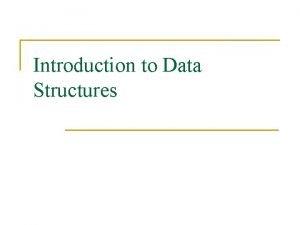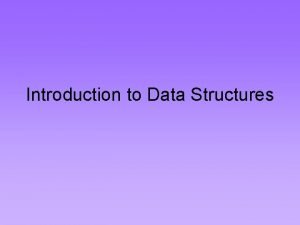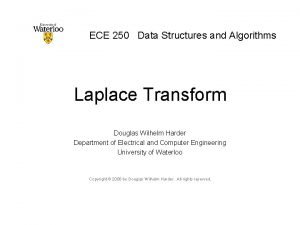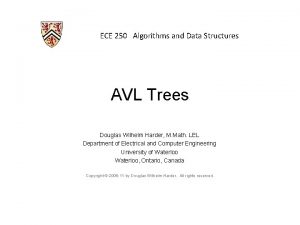ECE 250 Algorithms and Data Structures An introduction





















![Introduction to hash tables 22 References Wikipedia, http: //en. wikipedia. org/wiki/Hash_table [1] [2] Cormen, Introduction to hash tables 22 References Wikipedia, http: //en. wikipedia. org/wiki/Hash_table [1] [2] Cormen,](https://slidetodoc.com/presentation_image_h/12b38109281d695682c90b37dbefad2d/image-22.jpg)
- Slides: 22

ECE 250 Algorithms and Data Structures An introduction to hash tables Douglas Wilhelm Harder, M. Math. LEL Department of Electrical and Computer Engineering University of Waterloo, Ontario, Canada ece. uwaterloo. ca dwharder@alumni. uwaterloo. ca © 2006 -2013 by Douglas Wilhelm Harder. Some rights reserved.

Introduction to hash tables 2 9. 1 Outline Discuss storing unrelated/unordered data – IP addresses and domain names Consider conversions between these two forms Introduce the idea of hashing: – Reducing O(ln(n)) operations to O(1) Consider some of the weaknesses

Introduction to hash tables 3 9. 1. 1 Supporting Example Suppose we have a system which is associated with approximately 150 error conditions where – Each of which is identified by an 8 -bit number from 0 to 255, and – When an identifier is received, a corresponding error-handling function must be called We could create an array of 150 function pointers and to then call the appropriate function….

Introduction to hash tables 4 9. 1. 1. 1 Supporting Example #include <iostream> void a() { std: : cout << "Calling 'void a()'" << std: : endl; } void b() { std: : cout << "Calling 'void b()'" << std: : endl; } int main() { void (*function_array[150])(); unsigned char error_id[150]; function_array[0] = a; error_id[0] = 3; function_array[1] = b; error_id[1] = 8; function_array[0](); function_array[1](); return 0; Output: } %. /a. out Calling 'void a()' Calling 'void b()'

Introduction to hash tables 5 9. 1. 1. 1 Supporting Example Unfortunately, this is slow—we would have to do some form of binary search in order to determine which of the 150 slots corresponds to, for example, error-condition identifier id = 198 This would require approximately 6 comparisons per error condition If there was a possibility of dynamically adding new error conditions or removing defunct conditions, this would substantially increase the effort required…

Introduction to hash tables 6 Supporting Example 9. 1. 1. 2 A better solution: – Create an array of size 256 – Assign those entries corresponding to valid error conditions int main() { void (*function_array[256])(); for ( int i = 0; i < 256; ++i ) { function_array[i] = nullptr; } function_array[3] = a; function_array[8] = b; function_array[3](); function_array[8](); return 0; } Question: – Is the increased speed worth the allocation of additional memory?

Introduction to hash tables 7 9. 1. 3 Keys Our goal: Store data so that all operations are Q(1) time Requirement: The memory requirement should be Q(n) In our supporting example, the corresponding function can be called in Q(1) time and the array is less than twice the optimal size

Introduction to hash tables 8 Keys 9. 1. 3 In our example, we: – Created an array of size 256 – Store each of 150 objects in one of the 256 entries – The error code indicated which bin the corresponding function pointer was stored In general, we would like to: – Create an array of size M – Store each of n objects in one of the M bins – Have some means of determining the bin in which an object is stored

Introduction to hash tables 9 9. 1. 3 IP Addresses Examples: Suppose we want to associate IP addresses and any corresponding domain names Recall that a 32 -bit IP address are often written as four byte values from 0 to 255 – Consider 10000001 01100001010 101100112 – This can be written as http: //129. 97. 10. 179/ – We use domain names because IP addresses are not human readable

Introduction to hash tables 10 9. 1. 3 IP Addresses Similarly, the University of Waterloo has 216 IP addrescontrol of names within its domain – Any IP address starting with 129. 97 belongs to UW – This gives UW 2562 = 65535 IP addresses The University of Waterloo currently uses ~60 % of the IP addresses

Introduction to hash tables 11 9. 1. 3 IP Addresses Given an IP address, if we wanted to quickly find any associated domain name, we could create an array of size 65536 of strings: int const MAX_IP_ADDRESSES = 65536 string domain_name[MAX_IP_ADDRESSES]; For example, my computer is churchill. uwaterloo. ca and its IP address is http: //129. 97. 10. 179/ – The prefix 129. 97 is common to all u. Waterloo IP addresses – As 179 + 256 × 10 = 2739, it follows that domain_name[2739] = "churchill";

Introduction to hash tables 12 9. 1. 3 IP Addresses Under IPv 6, IP addresses are 128 bits – It combines what is now implemented as subnets as well as allowing for many more IP addresses Suppose u. Waterloo is allocated 264 IP addresses under this scheme – We cannot allocate an array of size 264

Introduction to hash tables 13 9. 1. 3 IP Addresses What if we want to associate domain names with IP addresses? – Which entry in the array should be associated with the domain name churchill. uwaterloo. ca ? Consider core routers on the Internet: – They must associate each IP address with the next router that address should be passed to

Introduction to hash tables 14 9. 1. 3 Simpler problem Let’s try a simpler problem – How do I store your examination grades so that I can access your grades in Q(1) time? Recall that each student is issued an 8 -digit number – How do I store your examination grades so that I can access your grades in Q(1) time? – Suppose Jane Doe has the number 20123456 – I can’t create an array of size 108 ≈ 1. 5 × 226

Introduction to hash tables 15 9. 1. 3 Simpler problem I could create an array of size 1000 – How could you convert an 8 -digit number into a 3 -digit number? – First three digits might cause a problem: almost all students start with 201, 202, 203, 204, or 205 – The last three digits, however, are essentially random Therefore, I could store Jane’s examination grade[456] = 86;

Introduction to hash tables 16 Simpler problem 9. 1. 3. 1 Question: – What is the likelihood that in a class of size 100 that no two students will have the last three digits? – Not very high:

Introduction to hash tables 17 9. 1. 3. 1 Simpler problem . . . 454 455 456 86 457 458 459 460 461 462 463 79 464 . . . 465 . . . – I can store something in that location – Storing it, accessing it, and erasing it is Q(1) – Problem: two or more students may map to the same number: – Wěi Wang has ID 20173456 and scored 85 – Alma Ahmed has ID 2024456 and scored 87 . . . Consequently, I have a function that maps a student onto a 3 -digit number

Introduction to hash tables 18 9. 1. 3. 1 The hashing problem The process of mapping an object or a number onto an integer in a given range is called hashing Problem: multiple objects may hash to the same value – Such an event is termed a collision Hash tables use a hash function together with a mechanism for dealing with collisions

Introduction to hash tables 19 9. 1. 3. 1 IP Addresses Going back to the problem with IP addresses – We need a hash function to map an IP address to a smaller range – We need a hash function to map a domain name to a smaller range Mapping 129. 97. 10. 179 onto a smaller range may seem easier, but a mechanism for mapping churchill. uwaterloo. ca onto a small range of integers may be more interesting

Introduction to hash tables 20 9. 1. 4 The hash process We will break the process into three independent steps: – We will try to get each of these down to Q(1) Object Techniques vary. . . 32 -bit integer Modulus, mid-square, multiplicative, Fibonacci Map to an index 0, . . . , M – 1 Deal with collisions Linear probing Quadratic probing Double hashing Chained hash tables Open addressing

Introduction to hash tables 21 Summary Discuss storing unordered data Discuss IP addresses and domain names Consider conversions between these two forms Introduce the idea of using a smaller array – Converted “large” numbers into valid array indices – Reduces O(ln(n)) in arrays and AVL trees to to O(1) Discussed the issues with collisions
![Introduction to hash tables 22 References Wikipedia http en wikipedia orgwikiHashtable 1 2 Cormen Introduction to hash tables 22 References Wikipedia, http: //en. wikipedia. org/wiki/Hash_table [1] [2] Cormen,](https://slidetodoc.com/presentation_image_h/12b38109281d695682c90b37dbefad2d/image-22.jpg)
Introduction to hash tables 22 References Wikipedia, http: //en. wikipedia. org/wiki/Hash_table [1] [2] Cormen, Leiserson, and Rivest, Introduction to Algorithms, Mc. Graw Hill, 1990. Weiss, Data Structures and Algorithm Analysis in C++, 3 rd Ed. , Addison Wesley. These slides are provided for the ECE 250 Algorithms and Data Structures course. The material in it reflects Douglas W. Harder’s best judgment in light of the information available to him at the time of preparation. Any reliance on these course slides by any party for any other purpose are the responsibility of such parties. Douglas W. Harder accepts no responsibility for damages, if any, suffered by any party as a result of decisions made or actions based on these course slides for any other purpose than that for which it was intended.
 Ajit diwan
Ajit diwan Princeton data structures and algorithms
Princeton data structures and algorithms Data structures and algorithms tutorial
Data structures and algorithms tutorial Information retrieval data structures and algorithms
Information retrieval data structures and algorithms Data structures and algorithms bits pilani
Data structures and algorithms bits pilani Ajit diwan
Ajit diwan Data structures and algorithms
Data structures and algorithms Data structures and algorithms
Data structures and algorithms Ian munro waterloo
Ian munro waterloo Signature file structure in information retrieval system
Signature file structure in information retrieval system Data structures and algorithms
Data structures and algorithms Algorithms + data structures = programs
Algorithms + data structures = programs Ece 222 github
Ece 222 github Ece 250
Ece 250 Ece 250
Ece 250 Ece 250
Ece 250 How are the whale flipper and the human arm different
How are the whale flipper and the human arm different Introduction of design and analysis of algorithms
Introduction of design and analysis of algorithms Introduction to the design and analysis of algorithms
Introduction to the design and analysis of algorithms Introduction to data structures
Introduction to data structures Introduction to data structures
Introduction to data structures An introduction to the analysis of algorithms
An introduction to the analysis of algorithms Bioalgorithms
Bioalgorithms








































